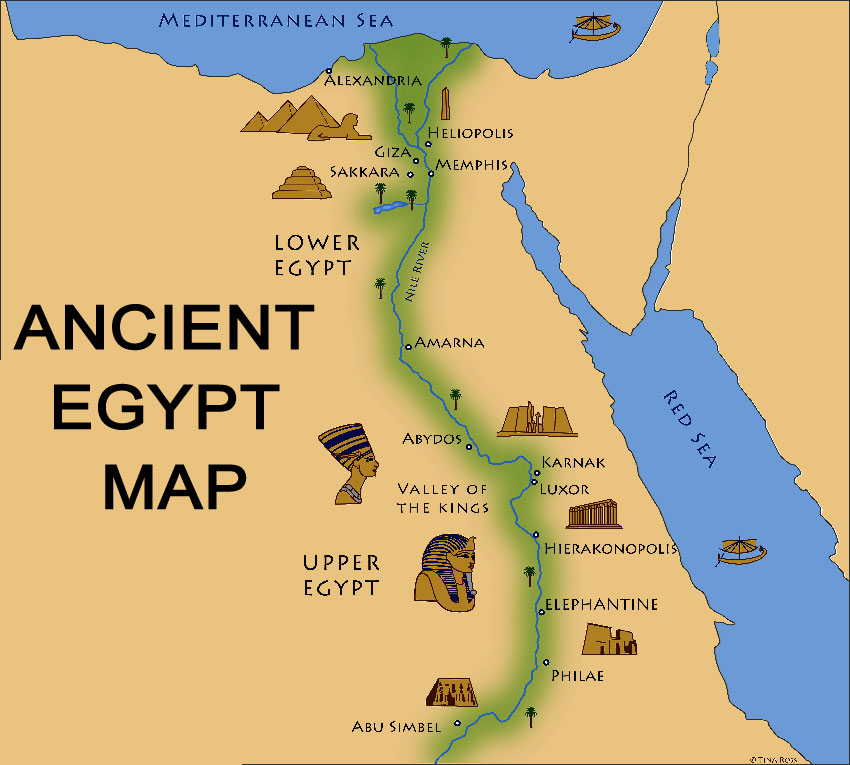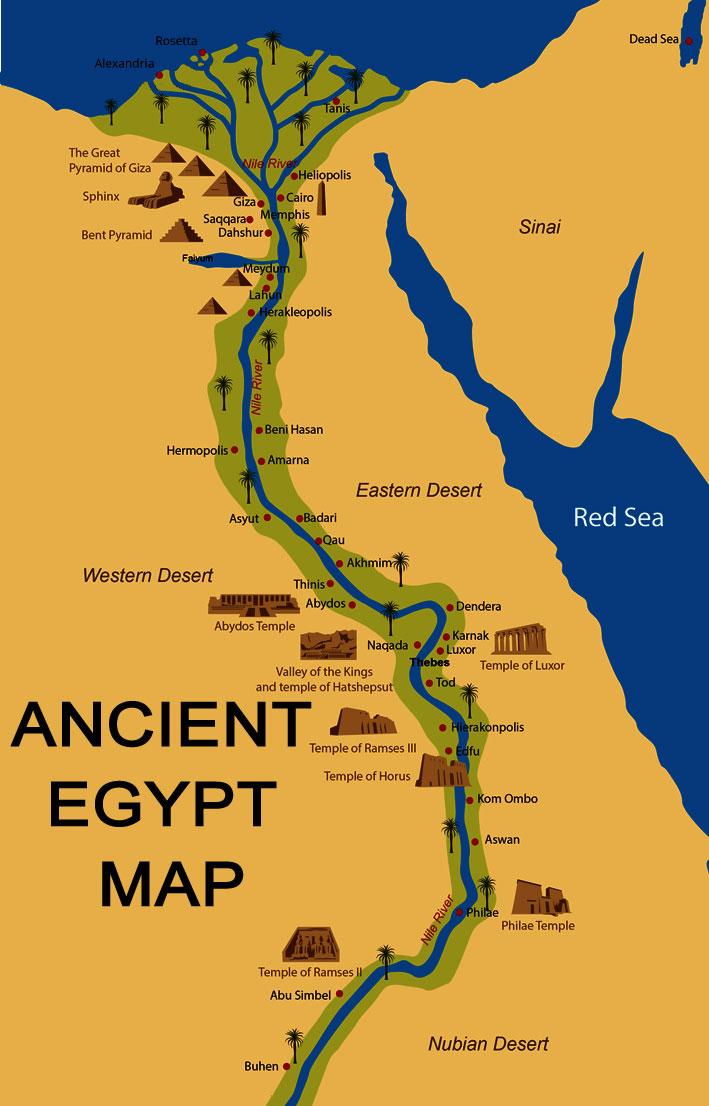Ancient Egypt map

The Importance of Maps in
Ancient Egypt
Ancient Egypt map played a
crucial role in ancient Egyptian society, serving a variety
of purposes(Maps and Their Place in Mesopotamia, Egypt,
Greece, and ..., n.d.). They were used for administrative,
religious, and military purposes, as well as for navigation
and trade. Maps were also used to depict the cosmos and the
afterlife, highlighting the importance of religion and
mythology in ancient Egyptian culture(During pharaohs times,
how did ancient Egyptians picture ..., n.d.). These maps
provided a reduced version of the real world, incorporating
selected properties of the existing or anticipated
environment(Maps and Mapmaking in Ancient Egypt, n.d.). Maps
were created by skilled artisans and scribes, who used
various techniques to accurately represent the
landscape(From Topography to Cosmos: Ancient Egypt's
Multiple Maps, n.d.).
Ancient Egypt map
The development of mapmaking
techniques in ancient Egypt was a significant achievement.
The Egyptians were able to create detailed maps of their
local area, including the Nile River and its surrounding
regions(Ancient Egypt Maps, n.d.). These maps were created
using a combination of surveying techniques, such as
measuring distances and angles, and artistic skills, such as
drawing and painting(From Topography to Cosmos: Ancient
Egypt's Multiple Maps, n.d.). The accuracy of these maps was
impressive, considering the limited technology and resources
available at the time. The Egyptians also used maps to plan
and construct their monumental architecture, such as the
pyramids and temples(Maps and Their Place in Mesopotamia,
Egypt, Greece, and ..., n.d.).
Ancient Egypt map
Ancient Egypt map held great
significance in ancient Egyptian religion and mythology.
They were used to depict the cosmos and the afterlife, which
were central to Egyptian beliefs(During pharaohs times, how
did ancient Egyptians picture ..., n.d.). The Nile River was
also considered a sacred entity, and maps were used to
represent its importance in Egyptian mythology(Ancient Egypt
Map, n.d.). Maps were often decorated with religious symbols
and hieroglyphs, emphasizing the spiritual significance of
the landscape(Did the ancient Egyptians have a world map?,
n.d.). The use of maps in religious and mythological
contexts further highlights the importance of cartography in
ancient Egyptian culture.
Ancient Egyptian
Geographical Knowledge and Mapmaking
Ancient Egypt map were known
for their advanced knowledge of geography and mapmaking,
particularly in regards to the Nile River and its
surroundings(The Nile River: Map, History, Facts, Location,
Source, n.d.). The Nile was the lifeblood of ancient Egypt,
and the Egyptians mapped its course and the surrounding
areas in great detail(Map of Ancient Egypt - World History
Encyclopedia, n.d.). They created maps that showed the
river's various channels, its floodplains, and the locations
of major cities and archaeological sites along its banks.
These maps were essential for the Egyptians' agricultural
practices, as they relied on the annual flooding of the Nile
to irrigate their crops. By understanding the river's course
and its surrounding geography, the Egyptians were able to
maximize their agricultural output and sustain their
civilization for thousands of years.
map of Ancient Egypt
Map of Ancient Egypt In addition to mapping the
Nile River, the ancient Egyptians also created maps of the
Egyptian Empire and its borders(Map of the Egyptian Empire -
Bible History, n.d.). These maps showed the extent of the
empire at different points in history, including the
Eighteenth Dynasty when it was at its greatest
extent(Ancient Egypt Maps, n.d.). They also marked important
cities, trade routes, and natural resources. These maps were
essential for the Egyptians' military and economic
endeavors, as they allowed them to plan their conquests and
trade routes more effectively. By understanding the
geography of the regions they sought to conquer or trade
with, the Egyptians were able to navigate unfamiliar
territories with greater ease and success.
Ancient Egypt map also
created maps that showed the location of natural resources
and trade routes(Trade, n.d.). These maps marked the
locations of important resources such as papyrus and wool,
as well as the trade routes that were used to transport
these resources to other parts of the empire and beyond.
These maps were essential for the Egyptians' economic
prosperity, as they allowed them to identify and exploit
valuable resources and trade opportunities. By understanding
the geography of the regions they traded with, the Egyptians
were able to establish lucrative trade relationships and
expand their economic influence throughout the ancient
world(Natural Resources of Ancient Egypt, n.d.). Overall,
the ancient Egyptians' advanced knowledge of geography and
mapmaking played a crucial role in their success as a
civilization.
Ancient Egyptian Maps
Ancient Egypt map One of the
oldest surviving maps of topographical interest from the
ancient world is the Turin Papyrus Map(Turin Papyrus Map,
n.d.). This ancient Egyptian map, dating back to around 1150
BC, depicts the gold mines in the Eastern Desert of
Egypt(Turin Papyrus Map (Illustration), n.d.). The map was
created by Amennakhte, a well-known scribe of the tomb, in
preparation for a quarrying expedition by Ramesses IV(Turin
Papyrus Map, c.1150 BC, n.d.). The map is an important
historical document, providing valuable information about
the mining operations and the surrounding landscape during
the New Kingdom period of Ancient Egypt. The Turin Papyrus
Map is a significant example of the ancient cartographic
techniques used by the Egyptians to represent the physical
world around them.
map of Ancient Egypt
The Karnak Temple Map is
another example of an ancient Egyptian map that provides
valuable insight into the geography and architecture of the
time. The Karnak Temple Complex, located near Luxor, Egypt,
is the largest ancient religious site in the world(Karnak,
n.d.). The complex comprises a vast mix of temples, pylons,
chapels, and other buildings, covering an area of 247
acres(Karnak Map - Temple - Qena Governorate, Egypt, n.d.).
The Karnak Temple Map, discovered on a scroll of papyrus
paper in the early 19th century, provides a detailed layout
of the temple complex(Turin Papyrus Map from Ancient Egypt,
n.d.). The map is an important historical document,
revealing the complex architectural design and construction
techniques used by the ancient Egyptians.
The Amarna Map is yet another
example of an ancient Egyptian map that provides valuable
information about the geography and architecture of the
time. The map shows the general layout of the central city
area of the 18th Dynasty Egyptian city of Akhetaten,
presently known as Tell el-Amarna(Map of Amarna, Egypt -
World History Encyclopedia, n.d.). The city was built by the
pharaoh Akhenaten as his new capital, and it provides a
unique insight into the religious and political changes that
took place during the Amarna period(Amarna: Mapping
Akhenaten's Forgotten Capital, n.d.). The Amarna Map is an
important historical document, providing valuable
information about the urban planning and architectural
design of the city(Amarna The Place, n.d.). The map is an
essential resource for scholars studying the history and
culture of Ancient Egypt(Amarna, n.d.)(Mapping Amarna -
Survey - Recent Projects, n.d.).
map of Ancient Egypt

|

